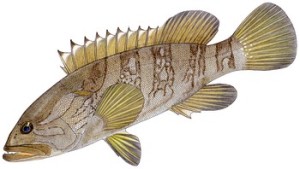江鮮單::班魚
班魚最嫩,剝皮去穢,分肝、肉二種,以雞湯煨之,下酒三分、水二分、秋油一分;起鍋時,加薑汁一大碗、蔥數莖,殺去腥氣

List of River Delicacies::Snakehead fish[1]
Snakehead fish are the most tender of all fish. To prepare it, skin the fish and clean-out its inedible innards.[2] Separate the fish’s liver from the flesh and braise them in chicken broth with three parts wine, two parts water, and one part autumn sauce. Prior to plating add one large bowl of ginger juice and many stalks of green onion to reduce its fishiness.[3]
Random notes:
[1]: Okay Yuan Mei, I give up. What is it with you lumping all these saltwater fish in the River Delicacies chapter? There are a tonnes of groupers around China, but none live in fresh water. Maybe this is here for the same reason that river delicacies are items that may be delicacies from the river or transported by river, but seriously, I don’t care anymore. You know what? Maybe I’ve been thinking of the wrong “班魚”. Although the name is commenly used for fish in the Grouper family, it is also relatively common to use it to refer to the fresh-water snakehead fish Channa argus, Channa maculatus, or Channa asiatica (山斑鱼). These fish are native or naturalized to the Yangtze river, are very tender and are braised to make medicinal soups, some of which are similar to the above recipe. Judging from (1) the recipe here being a weird one for groupers, (2) Yuan Mei does not mention any “typical” recipes for the fish and (3) the fact that groupers are NOT freshwater fish, I am starting to suspect that maybe Yuan Mei’s 班魚 is not from a spotted fish of Genus Epinephelus but rather one of the snake patterned fish from the Channa Genus. However, due to the lack of definitive information, I’m going to keep this section as grouper for now. But if the right piece of info comes, the name and content of the section will change.
[2]: Hui (穢) literally means “filth/unclean junk”. I assume it’s means innards like stomach, intestines, gills, and other whatnots. That said fish intestines (魚腸) are eaten in many Chinese cuisines, check out the famous dish: “Steam-roasted fish intestines“.
Hi great work on the translation and annotation.
I believe 班魚 is meant to be (baby) puffer fish. I found references from another annotation (late Qing dynasty) by 夏曾傅《随园食单补证》which is referenced by a contemporary article in https://3g.163.com/dy/article/DF9Q07QR0514PFTL.html.
I also found another book/text referencing to 班魚 to puffer fish. https://books.google.com.tw/books?id=wRFPDwAAQBAJ&pg=PT12&lpg=PT12&dq=%E7%8F%AD%E9%AD%9A+%E6%B2%B3%E8%B1%9A&source=bl&ots=oiSr0bGmrn&sig=ACfU3U28CwG8-IPJKizX6CQAZ_Fw5ZAnVw&hl=en&sa=X&ved=2ahUKEwjguJ68n_TfAhUl7GEKHQLmB4QQ6AEwEnoECAcQAQ#v=onepage&q=%E7%8F%AD%E9%AD%9A%20%E6%B2%B3%E8%B1%9A&f=false
Hence the need to separate skin and liver (sperm sack/shirako) is only often served separately.
I am also trying to annotate and cook my way through shidan.
LikeLiked by 1 person